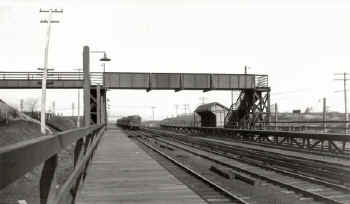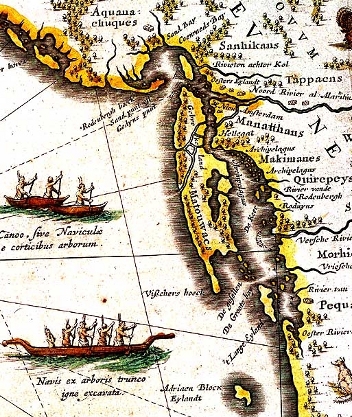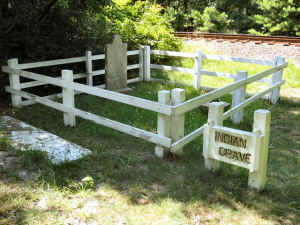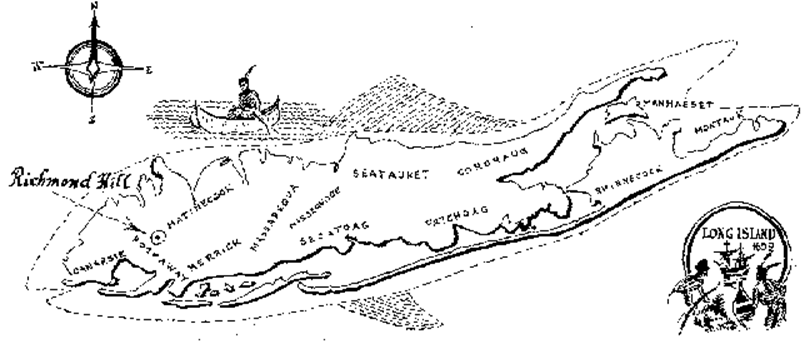|
LIRR
Heavyweight Parlor Cars
|
Number
|
Name |
|
| 99 |
JAMAICA |
A
family of Indians who resided near the bay, south of the Beaver
Pond, who were known as the ' Jameco' Indians" |
| 2000 |
JAMAICA |
| 2011 |
MONTAUK |
A name frequently
bestowed on high or hilly land throughout New England, and denotes "a place of observation",
"a place for seeing (or to be seen) far off" |
| 2012 |
SHINNECOCK |
Denotes "a
level country" where the Dutch found the tribe encamped in the
earliest days of the township. |
| 2013 |
PECONIC |
|
| 2014 |
AMAGANSETT |
|
| 2015 |
CUTCHOGUE |
|
| 2016 |
MATTITUCK |
|
| 2017 |
AQUEBOGUE |
|
| 2018 |
QUOGUE |
|
| 2019 |
MORICHES |
|
| 2020 |
PATCHOGUE |
|
| 2021 |
RONKONKOMA |
|
| 2022 |
ISLIP |
The
first people to settle in the area that is now named West Islip were
the Secatogue Indians, over one thousand years ago. So, ISLIP
has a more indirect "once removed" connection with Native
Americans. Info Jack Deasy |
| 2023 |
WYANDANCH |
|
| 2024 |
COPIAGUE |
|
| 2025 |
COMMACK |
|
| 2026 |
MASSAPEQUA |
|
| 2027 |
MERRICK |
|
| 2028 |
WANTAGH |
|
| 2029 |
MANHASSET |
|
| 2030 |
MINEOLA |
|
| 2031 |
NISSEQUOGUE |
|
| 2032 |
CAYUGA
CLUB |
|
| 2033 |
MOHAWK
CLUB |
|
| 2034 |
SENECA
CLUB |
|
| 2035 |
ONONDAGA
CLUB |
|
| 2036 |
ONEIDA
CLUB |
|
| 2037 |
TUSCARORA
CLUB later renamed
ONTEORA
|
|
| 2038 |
SETAUKET |
|
| 2039 |
NESCONSET |
|
| 2040 |
ASHAROKEN |
|
| 2041 |
MASTIC |
|
| 2042 |
SAGTIKOS |
|
| 2043 |
MATINECOCK |
|
| 2044 |
NOYACK |
|
| 2045 |
WAUWEPEX |
Means
"place of good water" |
| 2046 |
ONTEORA |
An
upstate New York Indian name |
| 2047 |
TECKAWITHA |
The
car was named for an Algonquin - Mohawk woman, whose name may be
rendered in English as Kateri Tekakwitha, also known as "The
Lily of the Mohawks", 1656-1670, born in Auriesville (now New
York), who was canonized a Saint by the Roman Catholic church in
2012. July 14th is the day the church celebrates her life each
year. Info: Jack Deasy
|
|
|
LIRR parlor cars that were named after Onteora
and Wauwepex. |
Harold Throop worked for the
LIRR as the General Manager of the Passenger Department from the
mid-60s until his retirement in 1971; and yes, his signature was on all
the
tickets. He was the 3rd ranking official at the railroad at that time.
Approximately 30 of these parlor cars were obtained by the LIRR in the
mid-60s. Most of them were purchased from the Pennsylvania Railroad for
next to nothing. My Dad was involved in the purchase of these cars, and
recalled going to Pennsylvania to look at one of them to determine whether
the LIRR should buy it. The railroad's Public Relations department got the
job of naming the cars, and decided to name them after locations on Long
Island, using mainly Indian names. My Dad went to Paul Blauvelt, the
LIRR's
Public Relations chief at the time, and suggested that 2 of the cars be
named after Onteora and Wauwepex. Mr. Blauvelt, also an avid Scouter, was
enthusiastic about this idea and the cars were so named.
My Dad did not recall the second Onteora car, although it appears that
this
car (also a fairly old one) replaced the first Onteora car once it was
retired. The second Wauwepex car, a modern rail car, was purchased after
my
Dad retired and the LIRR was made part of the MTA, and he was unaware of
the
naming of that one as well. Info: William Throop |
|
LIRR Lightweight Passenger Cars
|
|
|
|
LIRR Tug
Boats
|
| Tug
Name
|
Build Date
|
|
|
Montauk
|
1895
|
|
|
Syosset
|
1899
|
|
|
Patchogue
|
1907
|
|
|
Cutchogue
|
1918
|
|
|
Quogue
|
1919
|
|
| Meitowax
|
1926
|
One of the names of Long Island derived from
"the land of the periwinkle" or "country of the
ear-shell"
|
|
Current
LIRR Stations with Indian Names
|
| LIRR
Stations 2014 |
Station
Names - Current Indian Names
|
| Albertson |
|
| Amagansett |
Amagansett |
| Amityville |
|
| Atlantic
Terminal |
|
| Auburndale |
|
| Babylon |
|
| Baldwin |
|
| Bay
Shore |
|
| Bayside |
|
| Bellerose |
|
| Bellmore |
|
| Bellport |
|
| Belmont |
|
| Bethpage |
|
| Brentwood |
|
| Bridgehampton |
|
| Broadway |
|
| Carle
Place |
|
| Cedarhurst |
|
| Central
Islip |
|
| Centre
Avenue |
|
| Cold
Spring Harbor |
|
| Copiague |
Copiague |
| Country
Life Press |
|
| Deer
Park |
|
| Douglaston |
|
| East
Hampton |
|
| East
New York |
|
| East
Rockaway |
East
Rockaway |
| East
Williston |
|
| Far
Rockaway |
Far
Rockaway |
| Farmingdale |
| Floral
Park |
| Flushing
Main Street |
| Forest
Hills |
| Freeport |
| Garden
City |
| Gibson |
| Glen
Cove |
| Glen
Head |
| Glen
Street |
| Great
Neck |
| Great
River |
| Greenlawn |
| Greenport |
| Greenvale |
| Hampton
Bays |
| Hempstead |
Hempstead |
| Hempstead
Gardens |
Hempstead
Gardens |
| Hewlett |
|
| Hicksville |
|
| Hollis |
|
| Hunterspoint
Avenue |
|
| Huntington |
|
| Inwood |
|
| Island
Park |
|
| Islip |
|
| Jamaica |
Jamaica |
| Kew
Gardens |
|
| Kings
Park |
|
| Lakeview |
|
| Laurelton |
|
| Lawrence |
|
| Lindenhurst |
|
| Little
Neck |
|
| Locust
Manor |
|
| Locust
Valley |
|
| Long
Beach |
|
| Long
Island City |
|
| Lynbrook |
|
| Malverne |
|
| Manhasset |
Manhasset |
| Massapequa |
Massapequa |
| Massapequa
Park |
Massapequa
Park |
| Mastic
Shirley |
Mastic
Shirley |
| Mattituck |
Mattituck |
| Meadowlands |
|
| Medford |
|
| Merillon
Avenue |
|
| Merrick |
Merrick |
| Mets-Willets
Point |
|
| Mineola |
Mineola |
| Montauk |
Montauk |
| Murray
Hill |
| Nassau
Boulevard |
| New
Hyde Park |
| Northport |
| Nostrand
Avenue |
|
| Oakdale |
|
| Oceanside |
|
| Oyster
Bay |
|
| Patchogue |
Patchogue |
| Penn
Station |
| Pinelawn |
| Plandome |
| Port
Jefferson |
| Port
Washington |
| Queens
Village |
|
| Riverhead |
|
| Rockville
Centre |
|
| Ronkonkoma |
Ronkonkoma |
| Rosedale |
|
| Roslyn |
|
| Sayville |
|
| Sea
Cliff |
|
| Seaford |
|
| Smithtown |
|
| Southampton |
|
| Southold |
|
| Speonk |
Speonk |
| St.
Albans |
|
| St.
James |
|
| Stewart
Manor |
|
| Stony
Brook |
|
| Syosset |
Syosset |
| Valley
Stream |
|
| Wantagh |
Wantagh |
| West
Hempstead |
West
Hempstead |
| Westbury |
|
| Westhampton |
|
| Westwood |
|
| Woodmere |
|
| Woodside |
|
| Wyandanch |
Wyandanch |
| Yaphank |
Yaphank |
|
LIRR
Indian Names Locations no Longer Active
|
|
Napeague Beach:
Opened: sometime after 1903 for employees of
neighboring fish processing plants. Appears as signal stop in special
instructions of ETT #27: 6/25/1903. R. Emery states station razed: 12/5/27
and station stop discontinued, however ett #107: 12/26/27 lists station
stop in schedule pages but no stops indicated. No longer indicated in ETT
#108: 5/23/28 (Art Huneke data)
|
| White Pot
Junction:
The Dutch originally
colonized New York, shortly afterward in 1652 a group of
Englishmen from the Massachusetts Bay Colony came and settled in
the Dutch colony. They founded a town they called Newtown, which
included Whitepot, which later became Forest Hills. There are two
legends that surround the origin of the name Whitepot or Whiteput.
The first being The Dutch had named it for the hollow or pit,
"put" in Dutch, that was formed by a dry river bed in
the area. The second legend is that the land was sold to settlers,
by the local Indians, for three white clay pots.
|
| Matawok:
Probably
built 1910 with opening of Glendale cutoff located at Fleet St.
(formerly White Pot Rd.) under-grade crossing south of Whitepot
Jct. listed on ETT #58, effective: 9/8/1910. No indication of
station building, no trains indicated as stopping there, and it
does not appear on public timetables at all. Last listed on
ETT #69, effective. 5/25/13, missing from ETT effective: 5/27/14.
Research: Dave Keller
 Matawok
(Forest Hills West): A short-lived station immediately east of the
junction (Whitepot Jct.) of the Main Line and Rockaway Beach Line.
Station at 66th St. Built for the Matawok Land Co. which was
developing Forest Hills West. 400' wooden platforms with access by
means of two spans over the Main Line and seven spans over the
Rockaway Line. Opened 06/25/1922 and abandoned 07/1925
Vincent Seyfried Matawok
(Forest Hills West): A short-lived station immediately east of the
junction (Whitepot Jct.) of the Main Line and Rockaway Beach Line.
Station at 66th St. Built for the Matawok Land Co. which was
developing Forest Hills West. 400' wooden platforms with access by
means of two spans over the Main Line and seven spans over the
Rockaway Line. Opened 06/25/1922 and abandoned 07/1925
Vincent Seyfried
|
| There seems to be an interesting history associated with the name
"Matawok" referring to the place Long Island. As background, an
Algonquian native nation variously identified as Matouac, Matouwac, Metoac
(Dutch) or Montaukett (English) inhabited all
of Long Island east of the present-day Queens County line.
 A
Dutch map (1635) of Northeast Native territories shows the Matouwac
territory of Long Island. A
Dutch map (1635) of Northeast Native territories shows the Matouwac
territory of Long Island.
|
| Wampmissick:
4
miles east of Yaphank and 2 miles west of Manor. Appears on
the 1852-53 timetable only. Also used as a meeting/passing
location.
Appears on an 1855 map as a
siding at this location before the name: Wampmissick from 1916
LIRR Valuation Plans and in the LIRR’s 1924 CR4 book which
indicated freight siding locations.
Info: Art Huneke
|
|
Miscellaneous LIRR Indian Lore:
|
 The
grave of Reverend Paul
Cuffee, an Indian
of the Shinnecock Tribe. In years past, the LIRR engineers would
always toot the horn a few times when passing by the Chief's grave. I
believe that tradition has now been lost. Info: Dave Morrison The
grave of Reverend Paul
Cuffee, an Indian
of the Shinnecock Tribe. In years past, the LIRR engineers would
always toot the horn a few times when passing by the Chief's grave. I
believe that tradition has now been lost. Info: Dave Morrison
|
I'm aware of many more that never made it, just in
my Islip locale, for example: Winganhauppauge school and Creek (between
Islip/East Islip), Orowoc Creek (Bay Shore), Awixa Creek Area (Bay
Shore/Islip), and PENATAQUIT: the former name of Bay Shore (our Boy Scout
District name, BTW.) The above all part of the Secatogue tribe. The
list might be endless.... :-) Steven Lynch
|
|
"Indian Place-Names On Long Island and Islands Adjacent With Their
Probable Significations" by: William
Wallace Tooker, Algonkinist |


 A
Dutch map (1635) of Northeast Native territories shows the Matouwac
territory of Long Island.
A
Dutch map (1635) of Northeast Native territories shows the Matouwac
territory of Long Island. 